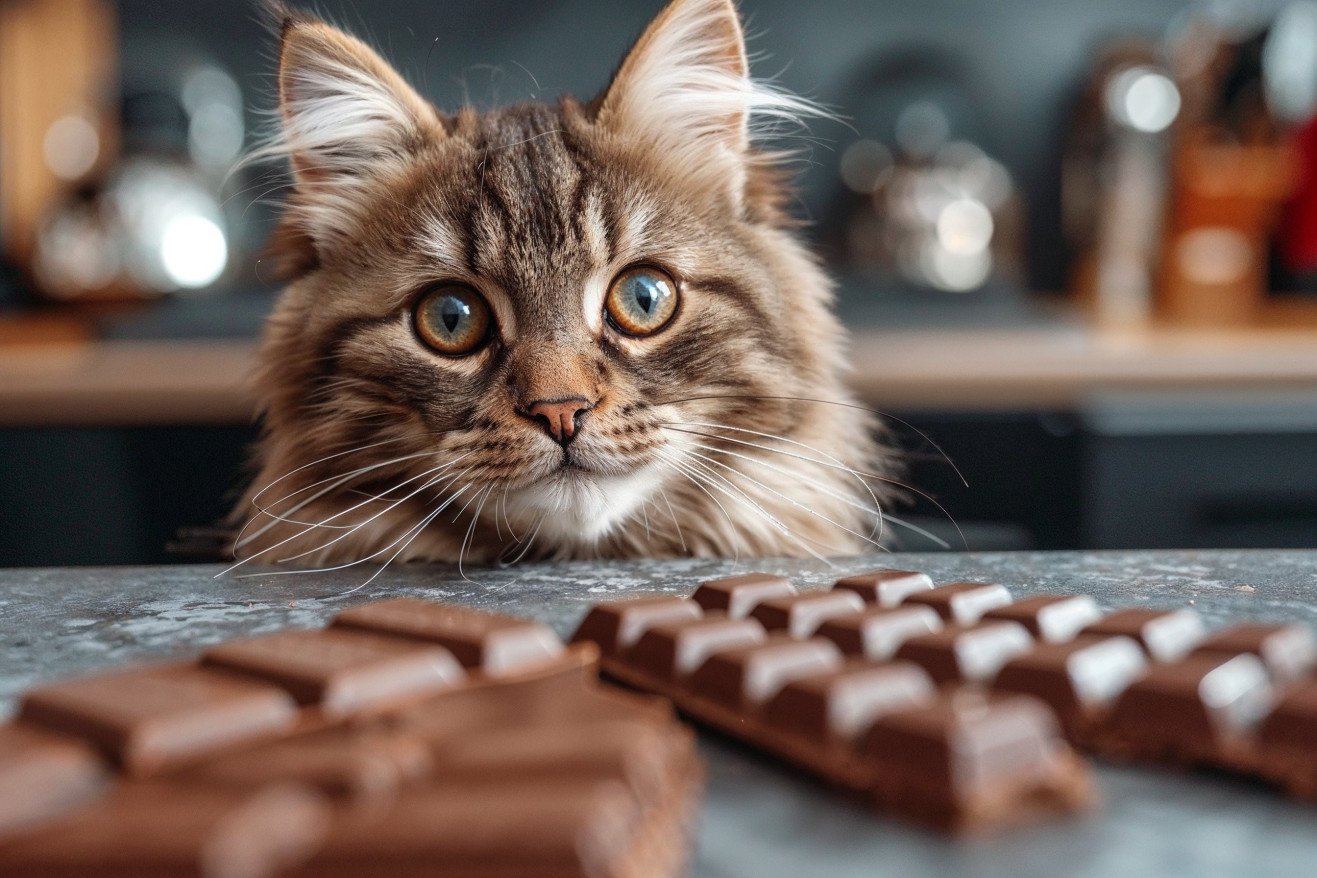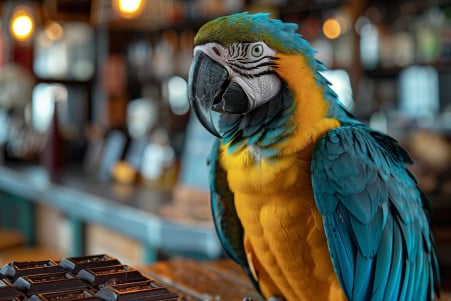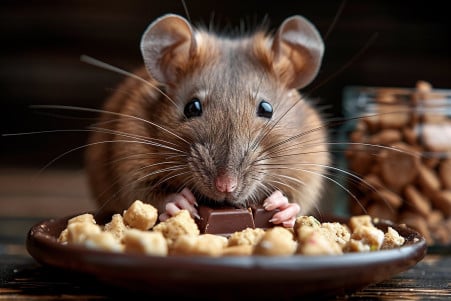Can Cats Eat Chocolate? Understanding the Risks and Toxicity
20 January 2024 • Updated 28 January 2024

Chocolate is a popular sweet for people, but is it safe for cats? No, cats can’t eat chocolate. Chocolate contains theobromine and caffeine, both of which are poisonous to cats and can lead to vomiting, diarrhea, seizures, and even death. If your cat eats chocolate, you should take them to the vet immediately. You should also make sure to keep chocolate out of your cat’s reach.
In the sections below, we will review scientific research from veterinary professionals and toxicologists to explain why chocolate is toxic to cats. This research includes clinical case reports, the physiological effects of chocolate’s toxic components, and comparisons of cats to other animals. Together, this information will give you a thorough understanding of feline biology, how to avoid chocolate toxicity, and what to do if your cat accidentally eats chocolate.
Can cats eat chocolate without experiencing adverse health effects?
Breaking Down the Toxic Response: Theobromine and Caffeine in Cats
Theobromine and caffeine in chocolate are toxic to cats and can cause a range of health problems. According to the Merck Veterinary Manual, these substances are rapidly absorbed from the gastrointestinal tract, metabolized in the liver, and excreted in the urine.
The toxic effects of these methylxanthines are the result of competitive inhibition of adenosine receptors, which leads to tachycardia, CNS stimulation, and diuresis. They also increase intracellular calcium and circulating catecholamines, which increases muscle contractility and can cause diarrhea, tachypnea, and even fatal ventricular arrhythmias.
Cats, due to their metabolism, lack the enzymes needed to effectively metabolize theobromine and caffeine, which makes them especially susceptible. PetMD and the Pet Poison Helpline explain that the concentration of these substances varies by chocolate type, with dark chocolate and baking chocolate containing the highest levels and white chocolate containing the lowest levels, although even white chocolate can be toxic.
If a cat has ingested chocolate, it is critical that they receive immediate veterinary care. Veterinarians may treat the cat by inducing vomiting, administering activated charcoal, and providing supportive therapies such as fluid diuresis to help the body eliminate the toxins. The sooner a cat receives medical care, the better their chances of recovery, which underscores the importance of knowing and being able to identify the symptoms of chocolate toxicity.
Chocolate Poisoning: Cats vs. Dogs
Even though both cats and dogs are susceptible to chocolate poisoning, it is much more common in dogs. In fact, a study in PMC found that chocolate was responsible for 25% of acute intoxication presentations in dogs. Cats are less likely to eat chocolate because they can’t taste sweetness, as noted by Compassionate Animal Care, and this may be one reason that there are fewer reported cases of chocolate poisoning in cats.
To prevent chocolate poisoning in both cats and dogs, owners should make sure to keep chocolate out of their pet’s reach, especially during the holidays when cases of chocolate poisoning are known to spike, according to research in PMC. While the clinical signs of chocolate poisoning in cats and dogs are similar, the way they are treated can differ because of physiological differences that require species-specific protocols.
It is important to educate pet owners about the dangers of chocolate, as noted in the study Household Food Items Toxic to Dogs and Cats in PMC, to help reduce the risk of accidental ingestion. This can be done through public awareness campaigns and veterinary guidance, and it can help to reduce these preventable cases and keep our beloved pets safe.
Decoding Feline Sensitivity: Metabolic Pathways and Chocolate Toxicity
The metabolic pathways of cats play a major role in how they react to chocolate. Most notably, cats have a deficiency in several enzymes that are involved in detoxification, especially in the metabolism of theobromine and caffeine, the two compounds in chocolate that are most dangerous to pets.
An article in ScienceDirect notes that cats have a deficiency in glucuronidation, a phase II detoxification pathway in which glucuronic acid is conjugated to toxic substances, making them less water-soluble and easier to excrete. This deficiency is due to a lack of the enzymes involved in the conjugation process, including the UDP-glucuronosyltransferase (UGT) enzymes UGT1A6 and UGT1A9.
In contrast, dogs and humans have a more robust glucuronidation pathway, which is why they can tolerate higher levels of theobromine and caffeine.
As an article in PMC points out, this difference in metabolism means that cats are more susceptible to the toxic effects of chocolate because their bodies can’t get rid of the toxic substances as effectively. As a result, more aggressive supportive care is often needed in the treatment of chocolate poisoning in cats to make up for their metabolic deficiencies.
This information is important for veterinarians to know so they can tailor their treatment plans to the unique needs of their feline patients. It also emphasizes the importance of protecting cats from chocolate poisoning since their metabolic pathways make them especially susceptible to its toxic effects.
Taste Preferences and Chocolate Toxicity
Cats’ taste preferences are a result of their biology and behavior and can impact their likelihood of consuming chocolate. According to Scientific American, cats don’t have the genes that code for sweet taste receptors, which makes them “sweet blind,” a characteristic that is unusual among mammals. The lack of sweet taste receptors means that cats are less likely to be interested in chocolate and therefore less likely to be exposed to theobromine and caffeine.
Cats are obligate carnivores, which means that they have evolved to eat a diet that is high in protein, and their taste preferences reflect this. As a study in PMC explains, cats prefer amino acids to sweet tastes. This means that their taste preferences are geared toward meat rather than carbohydrates or sweets, which further reduces the likelihood of chocolate exposure.
Cats also display neophilia and neophobia, which can impact their willingness to eat new foods. While some cats may be neophilic and willing to try new foods like chocolate, others may be neophobic and avoid potentially toxic substances.
This knowledge, which is highlighted in Scientific American and the study “Taste preferences and diet palatability in cats,” can be important for cat owners to know in order to prevent accidental chocolate exposure and ensure that their cats are safe from dietary harm.
Getting Help: Treatment and Recovery for Cats
If your cat has eaten chocolate, it is important to get them to the vet as soon as possible. According to Vets Now, if the cat is brought in quickly and is not yet showing symptoms, treatment may begin with the induction of vomiting to get the toxins out of the cat’s system.
Activated charcoal may also be used to absorb any remaining toxins in the stomach and intestines. The Merck Veterinary Manual explains that intravenous fluids may be given to help the kidneys function properly and to aid in the excretion of the toxins from the body.
While the prognosis for chocolate toxicosis in cats is generally good, as Vetster explains, cats may experience gastrointestinal upset and, in more severe cases, long-term issues like heart arrhythmias or seizures. Recovery will typically involve supportive treatment, including monitoring and medications, and symptoms will usually resolve within a few days.
It is important for pet parents to make sure that they are keeping chocolate in a safe place and to get in touch with a vet as soon as possible if they suspect that their cat has ingested chocolate.
Being watchful and acting quickly will help ensure that your cat makes a full recovery. It is important to note that professional veterinary care is essential in cases of chocolate poisoning. As always, prevention is better than treatment, so make sure to keep your chocolate out of your pets’ reach.
Summary of Chocolate Toxicity in Cats
This in-depth review has repeatedly emphasized the serious danger that chocolate poses to cats. Theobromine and caffeine, the toxic chemicals in chocolate, can lead to a range of health problems in cats, from digestive upset to heart problems, and even death. Cats’ metabolic pathways make them especially vulnerable to the toxic effects of chocolate.
We’ve also compared the likelihood of chocolate toxicity in cats to that in dogs, pointing out that cats are less likely to eat chocolate because of their taste preferences and eating habits, but the danger is just as serious. Cats’ status as obligate carnivores and their unique eating habits mean they are less likely to eat chocolate, but this doesn’t mean that cat owners can let down their guard.
The steps that cat owners can take to prevent chocolate toxicity are straightforward but essential: they need to make sure that chocolate is stored where their cats can’t get to it. Responsible pet owners not only protect their pets from known hazards but also learn about their pets’ specific needs and potential health risks.
By making sure that they understand and are informed about their cats’ dietary needs, cat owners can help ensure that their pets stay safe and healthy and never have to deal with the dangers of chocolate toxicity.


